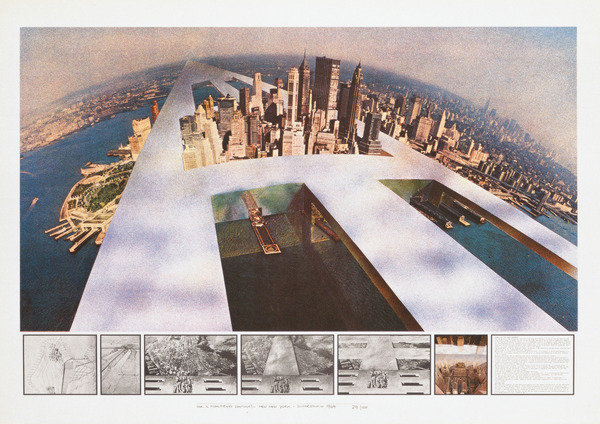Concrete
dal 28/2/2013 al 19/5/2013
Segnalato da
William Henry Fox Talbot
Domenico Bresolin
Charles Marville
Germaine Krull
Lucia Moholy
Julius Shulman
Georg Aerni
Iwan Baan
Luisa Lambri
Hiroshi Sugimoto
Wolfgang Scheppe
Thomas Seelig
Daniela Janser
28/2/2013
Concrete
Fotomuseum Winterthur, Winterthur
Photography and Architecture. The exhibition seeks to approach the singular and complex relationship between architecture and photography in light-hearted, narrative and dialectical ways. The exhibition explores issues of history and ideology, as well as the specifics of form and material, in the photographic image: more than 400 photographs and groups of works from the 19th, 20th and 21st centuries.

Architectures and cities are both volumes and images alike. We experience them directly, physically and sensually, as well as through pictures. Pictures speak a language of their own. They offer a discourse that is quite unlike the physical experience of architecture. They transform volume into surface; distil matter into forms and signs – rarely, if ever, leaving it as it is. That is probably why so many architects try to get involved in determining the image of their buildings. Concrete – Photography and Architecture seeks to approach the singular and complex relationship between architecture and photography in light-hearted, narrative and dialectical ways. The exhibition explores issues of history and ideology, as well as the specifics of form and material, in the photographic image.
The visual appeal of destroyed or dilapidated buildings is also addressed, as are their powerful demonstrations of power and exclusivity, fragility and beauty. To what extent does photography influence not only the way architecture is perceived, but also the way it is designed? How does an image bring architecture to life, and at what point does it become uncanny? How do settlements develop into cities? Or, in sociological terms: how do work and life interconnect differently in, say, Zurich and Winterthur, as opposed to, say, Calcutta? And how do skyscrapers and living spaces translate into the flat, two-dimensional world of photography?
Concrete – Photography and Architecture is not, however, chronologically arranged. Instead, it is based on compelling positions, counterpositions and thematic fields that connect various concrete, fundamental and historical aspects. Alongside everyday buildings and prestigious architecture, structured by horizontal and vertical axes, alongside homes and houses, utopian fantasies, design and reality, an important aspect of the exhibition is the compelling appeal of architectural decay due to the passage of time, through both natural and deliberate destruction. It is almost as though photography were providing a moral reminder even such magnificence and presence, whether hewn in stone or cast in concrete, has its weaknesses too.
Architecture has always been an important platform for the frequently heated discussion of ideas and views, zeitgeist and weltanschauung, everyday life and aesthetics. Architecture is the bold materialisation of private and public visions, functionality and avant-garde art alike. It is, as Slavoj Žižek puts it, ideology in stone. Photography and architecture both play an undisputed role in our everyday lives. They confront us on a daily basis, often without our even noticing, and they influence how we think, act and live in subliminal and lasting ways. Concrete – Photography and Architecture provides visual answers to the question of what it is that makes up the intimate yet complex relationship between architecture and photography, architect and photographer.
The exhibition presents more than 400 photographs and groups of works from the 19th, 20th and 21st centuries, including William Henry Fox Talbot, Domenico Bresolin and Charles Marville as well as Germaine Krull, Lucia Moholy and Julius Shulman, and spanning an arc to contemporary works by Georg Aerni, Iwan Baan, Luisa Lambri and Hiroshi Sugimoto. Projects such as the long-term observations of Schlieren photography or Wolfgang Scheppe‘s Migropolis show how the art of photography is playing an increasingly important role as an instrument of research and knowledge. Curator: Thomas Seelig. Research Assistant: Daniela Janser.
The exhibition is accompanied by a lavishly illustrated book published by Scheidegger & Spiess, with some 300 colour and black-and-white pictures, essays by Jochen Becker, Johannes Binotto, Verena Huber Nievergelt, Michael Jakob, Nicoletta Leonardi, Lorenzo Rocha, Caspar Schärer, Aveek Sen and Urs Stahel as well as a conversation with Annette Gigon, Meret Ernst and Armin Linke.
Main sponsors: Vontobel Foundation and the Lottery Fund of the Canton of Zurich.
Fringe programme:
Tuesday, 5 March 2013, 12.15 p.m.: Image Focus at Noon with Natalie Madani: 'Sever/Isolate' – Willie Doherty and the photographic visualisation of 'boundaries'.
Wednesday, 27 March 2013, 7 p.m.: Jubilee Tour with Ernst Wohlwend, former Mayor of the City of Winterthur.
Wednesday, 10 April 2013, 7 p.m.: Jubilee Tour with Mike Guyer, architect and co-proprietor of Gigon Guyer Architekten.
Wednesday, 24 April 2013, 7 p.m.: Jubilee Tour with Stefan Zweifel, philosopher.
Tuesday, 7 May 2013, 12.15 p.m.: Image Focus at Noon with Astrid Näff: Scenes of Nostalgia: The King’s Tent in the Winter Garden and Corporate Arcadia.
Tuesday, 14 May 2013, 19.30 p.m.: Jubilee Reading saying water by artist Roni Horn.
Wednesday, 15 May 2013, 7 p.m.: Jubilee Tour with Philip Ursprung, Professor of History of Art and Architecture.
Image: Superstudio, New New York, From Il monumento continuo, 1969
Museum and foundation secretary, press: Martina Egli egli@fotomuseum.ch
Press Conference and Opening:
Friday, 1 March 2013, 10 to 12 a.m. and 6 to 9 p.m.
Fotomuseum Winterthur
(Main Gallery + Gallery + Gallery of Collection)
Opening hours of the exhibitions:
Tuesday to Sunday 11 a.m. - 6 p.m., Wednesday 11 a.m. to 8 p.m., closed on Mondays
Opening hours and holidays:
Open: Easter Sunday and Monday, May 1 (till 6 p.m.), Ascension Day, Pentecost and Pentecost Monday, August 1, December 24 (till 4 p.m.), December 26 (till 6 p.m.), December 31 (till 4 p.m.) and January 2, 2014.
Closed: Good Friday, December 25 and January 1, 201
Admission:
Fr. 15.- (with reduction Fr. 12.-)



